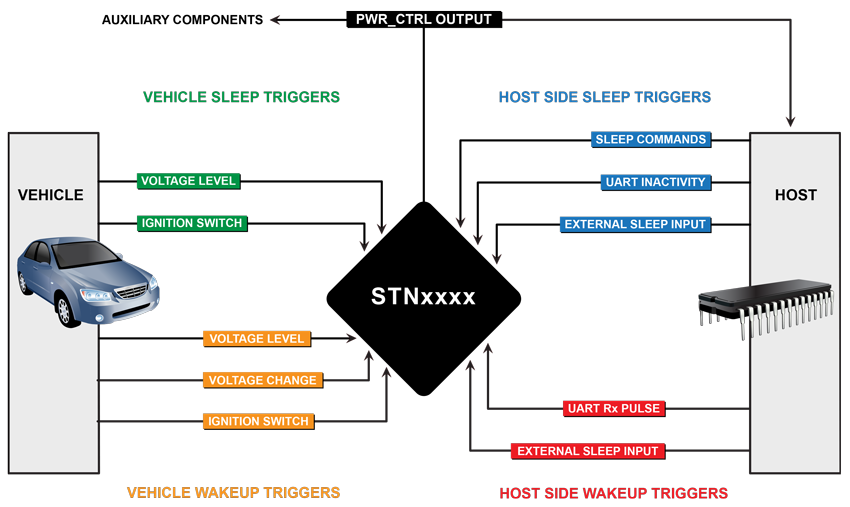Details
On-Board Diagnostics, Second Generation (OBD-II) is a set of standards for implementing a computer based system to control emissions from vehicles. It was first introduced in the United States in 1994, and became a requirement on all 1996 and newer US vehicles. Other countries, including Canada, parts of the European Union, Japan, Australia, and Brazil adopted similar legislation. A large portion of the modern vehicle fleet supports OBD-II or one of its regional flavors.
Among other things, OBD-II requires that each compliant vehicle be equipped with a standard diagnostic connector (DLC) and describes a standard way of communicating with the vehicle’s computer, also known as the ECU (Electronic Control Unit). A wealth of information can be obtained by tapping into the OBD bus, including the status of the malfunction indicator light (MIL), diagnostic trouble codes (DTCs), inspection and maintenance (I/M) information, freeze frames, VIN, hundreds of real-time parameters, and more.
STN1110 is an OBD to UART interpreter that can be used to convert messages between any of the OBD-II protocols currently in use, and UART. It is fully compatible with the de facto industry standard ELM327 command set. Based on a 16-bit processor core, the STN1110 offers more features and better performance than any other ELM327 compatible IC.
Feature Highlights
- Fully compatible with the ELM327 AT command set
- Extended ST command set
- UART interface (baud rates from 38 bps to 10 Mbps)
- Secure bootloader for easy firmware updates
- Superior automatic protocol detection algorithm
- Large memory buffer
- Voltage input for battery monitoring
- Available in SPDIP, SOIC and QFN-S packages
- RoHS compliant
Stability
- Solid, field-tested software. STN1110 runs the same proven code that powers the popular OBDLink family of PC-based OBD interfaces. Thanks to its large user base, any problems are discovered and corrected quickly.
- Large OBD message buffer. STN1110 has over five times as much RAM as its nearest competitor, virtually eliminating BUFFER OVERFLOW errors.
- Automatic protocol detection algorithm is continuously fine-tuned to insure that STN1110 will connect to the widest array of vehicles, even those that do not fully conform to the OBD standard.
PowerSave Sleep/Wakeup Triggers
The diagram shows the various triggers available in the STN11xx family of ICs. Please refer to the STN11xx PowerSave Functionality documentation for more details.

Additional Info
| DEVICE WEIGHT |
|
|---|---|
| DIMENSIONS |
|
| OPERATING VOLTAGE | 3-3.6V DC |
| OPERATING CURRENT | 63 mA |
| BATTERYSAVER™ MODE | < 2 mA |
| OPERATING TEMPERATURE | -4° to 185°F (-40° to 85°C) |
-
All legislated OBD II protocols:
- ISO 15765-4 (CAN 250/500 kbps, 11/29 bit)
- ISO 14230-4 (Keyword Protocol 2000)
- ISO 9141-2 (Asian, European, Chrysler)
- SAE J1850 VPW (GM)
- SAE J1850 PWM (Ford)
-
Non-legislated OBD protocols:
- ISO 15765
- ISO 11898 (raw CAN)
- SAE J1939 OBD protocol used in heavy-duty vehicles
STN IC Comparison Chart
| UART interface | ||||
| Compatible with ELM327 AT command set | ||||
| Extended ST command set | ||||
| PowerSave™ sleep/wake triggers | ||||
| Secure bootloader | ||||
| Automatic protocol detection algorithm | ||||
| RAM | ||||
| Flash | ||||
| Performance (MIPS) | ||||
| Suppors all legislated OBD-II protocols | ||||
| GM Single-Wire CAN (SW-CAN) | ||||
| Medium-Speed CAN (MS-CAN) | ||||
| J1939 | ||||
| Advanced security options | ||||
| Recommended for new designs | ||||
| Unit pricing (10k pieces; USD) |








